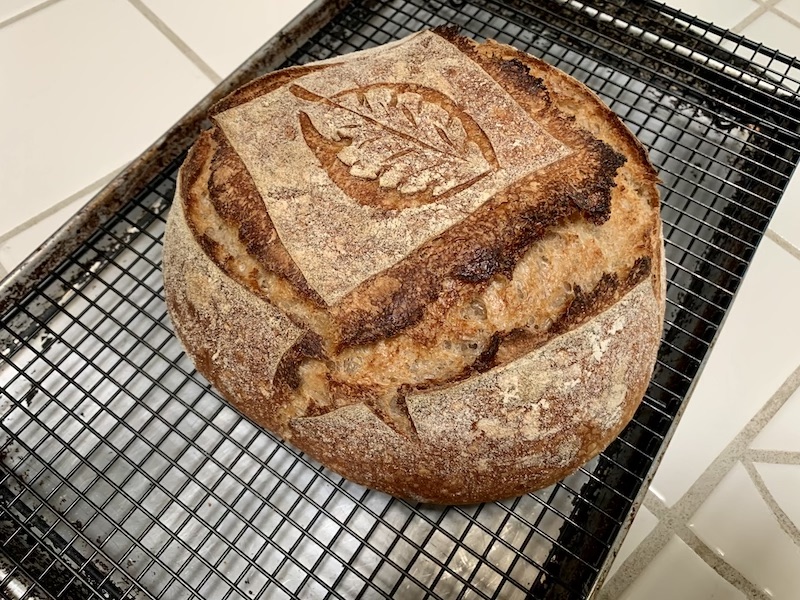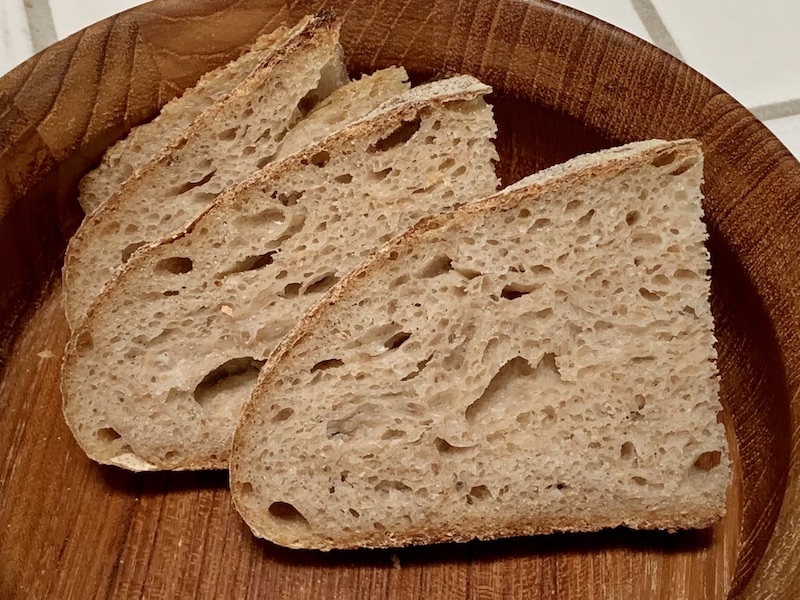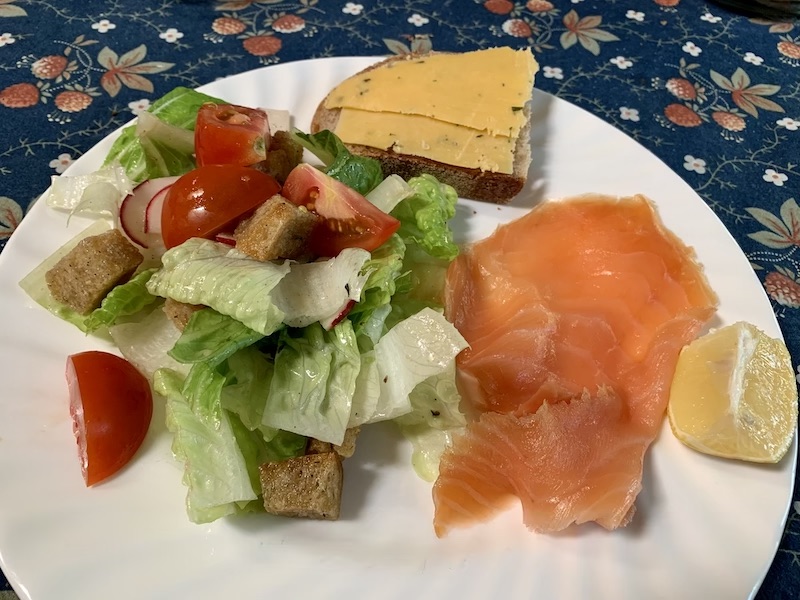Multi-grain Sourdough Bread with Home-Milled Flours
David M. Snyder
November, 2020
Those who read my blog on The Fresh Loaf know that I have been experimenting with different proportions of home-milled flours over the past couple years. About a year ago, I found a mix of flours that makes breads with the most wonderful flavor. I have occasionally re-visited old favorites, but, really, this is the best of class. Of course, it is “best” to my taste. Yours may be different.
Recently, I looked through my blog postings and became aware that I have never posted this exact formula. So, here it is:
Total Dough (This is for two 900 g loaves) | ||
Ingredient | Wt (g) | Bakers' % |
Bread Flour | 700 | 70 |
Whole Wheat flour | 125 | 12.5 |
Whole Rye flour | 75 | 7.5 |
Whole Spelt flour | 100 | 10 |
Water | 780 | 78 |
Salt | 21 | 2.1 |
Total | 1801 | 180.1 |
Note: The whole grain wheat, rye and spelt flours are milled in a Mockmill 100 mill set at its finest setting. The flour is milled immediately before mixing.
Levain |
|
|
Ingredient | Wt (g) | Bakers' % |
Bread flour (hi protein) | 144 | 75 |
Whole Wheat flour | 36 | 25 |
Water | 144 | 75 |
Active starter | 36 | 25 |
Total | 360 | 200 |
Dissolve the starter in the water. Add the flours and mix thoroughly.
Transfer to a clean container, cover and ferment until ripe (6 hours for me.) If you don't use it immediately, it can be kept in the refrigerator for up to 3 days.
Final Dough |
|
Ingredient | Wt (g) |
Bread flour (AP) | 540 |
Whole Wheat flour | 85 |
Whole Rye flour | 75 |
Whole Spelt flour | 100 |
Water (85-95ºF) | 620 |
Salt | 21 |
Active levain | 360 |
Total | 1801 |
Procedures
Mix the flours with the water to a shaggy mass.
Cover and let sit at room temperature for 45-120 minutes. (Autolyse)
Sprinkle the salt over the dough surface and add the levain in 4 to 6 portions.
Mix thoroughly. (I start by folding in the salt and levain with a silicon spatula. Then, I use the method Forkish specifies – squeezing the dough between my fingers alternating with stretch and folds in the bowl. I wear a food service grade glove and dip my working hand frequently in water.)
Transfer the dough to a lightly oiled, clean bowl large enough to accommodate doubling in volume. Cover well.
Ferment at 80ºF for 3 – 3.5 hours with stretch and folds in the bowl at 30 and 60 minutes, then a lamination fold on the board at 1:45-2:00 hours. The dough should have nearly doubled in volume and be quite puffy.
Transfer the dough to a well-floured board.
Divide the dough as desired and pre-shape in rounds. Cover with a cloth and let rest for 20-30 minutes.
Shape as boules or bâtards and place in floured bannetons. Place these in food-grade plastic bags sealed with ties and let proof for 30-60 minutes at room temperature. Refrigerate 8 hours or up to 36 hours at 40ºF.
The next day, pre-heat oven. Let the loaves sit at room temperature while the oven pre-heats. You can bake on a baking stone with steam for the first part of the bake, or in Dutch ovens, as you prefer. The oven temperature and length of the bake will depend on which of these methods you choose and on the weight and shape of your loaves, as well as on how dark you prefer your crust. When done, the loaves should sound hollow when thumped on their bottoms. The internal temperature should be at least 205ºF.
Let the loaves cool completely on a rack for 1-2 hours before slicing.
This loaf was baked in a Cast Iron Dutch oven at 475ºF for 30 minutes covered, then 20 minutes un-covered at 450ºF.


This bread is so delicious, i could make a meal of it alone, but it is also wonderful with other food. I baked this loaf this morning, and we had some for lunch with a salad, cheese and smoked salmon.

Happy baking!
David
- dmsnyder's Blog
- Log in or register to post comments
David - true to form your breads always look so good. I like the scoring too. I've bookmarked this and will give it a try. I'm finally getting around to getting a mill this winter and have just decided this will be the first fresh milled bread I'll make with it! Thanks for posting.! frank!
Thanks!
What mill are you planning to get? I find, after using my for almost all my breads, there is no turning back.
David
David, this bread looks and sounds wonderful and I’ve bookmarked it to try. Thanks for sharing your detailed formula for your bread with us,
Benny
If you make it, let us know how you like it.
David
That's a lovely bread, David, and I'm sure that it tastes as good as it looks, given the flours used. It reminds me of a Pain de Campagne, with slightly higher percentages of the whole-grain flours. PdC happens to be one of my favorites, so I'm biased toward liking what you've done with this bread.
While there's probably a point of diminishing returns somewhere, I wonder what would happen if the whole-grain flours were pushed to an aggregate 50% of the flour bill?
Paul
In fact, this is in many ways similar to some PdC I had in Les Eyzies, Dordogne, France. Except that was a huge piece cut off a miche that must have weighed 5 kg or more. And I'm sure it was baked in a wood-fired oven.
I have made a very similar bread at 75% whole wheat, but not a 50% mixed whole grain version. I like your suggestion and may give it a try.
David
Interesting that you are using the same flour mix as Gérard Rubaud used to, ie whole wheat, spelt and rye, although not in the same proportions.
Lance
Hi David, I can almost smell these breads from the pictures.
I have also been playing around with various blends of fresh milled grains in my breads and curiously have come up with similar proportions. I have found the sweet spot to be between 30-40% of the fresh milled stuff to give a nicely open crumb with the distinctive flavors of the wheat.
You did not mention what type of wheat berries you are using. What I have found is that when using ancient grains like khorasan or einkorn, and to a lesser extent spelt, if I use hard red wheat it tends to overwhelm the sweetness inherent in the ancient grain. Now, if I have any around, I try to use white wheat because its flavor is a bit milder. I love the flavor of the hard red, but to highlight the spelt and others I think the white works better, at least for my tastes. Just a thought.
-Brad
Something else to try.
David
David, whenever you say something like, "best in class," I have to bake it, and have a boule and a bâtard in the fridge for baking tomorrow morning. I've been baking bread off and on since taking a bread baking course from the then White House chef in 1980, but have only been into sourdough for the past couple of years. I live 15" from Forkish's bakery, which influenced me to pick up his book, but after baking everything in FWSY, and most of the breads in Tartine, I discovered your blog. I frequented San Francisco in my youth in the early 60's, and had my share of the real sourdough, and have enjoyed baking your San Francisco-style recipes, and I have been working my way through many others as you bake the kind of bread I like to eat. Thanks for your blog and sharing your joy of bread baking.
Richard
You are welcome! Please let us know how this turns out for you.
I love Portland and not just because of the bakeries. I went to college there, and one of my sons lives in SW Portland.
David
I'm new to taking bread photos, but the loaves turned out great and are a perfect combination of flavors for a multigrain bread. We do have several great bakeries in Portland, but I've been impressed with the organic wheat grown in the Pacific Northwest and the ability to order it freshly milled. Richard
Nice job, Richard.
If it's not clear, this formula is a riff on Ken Forkish's "Field Blend No. 2." So, it has Portland roots.
David
I have been using my home mill to make whole rye and whole wheat in a small amount to add to my sourdoughs. I usually add rye or wheat between 10% to 50% with great results. I have some spelt grain that I couldn't decide on what to do with. Your recipe looks enticing so I will give it a go in the near future. Thanks for sharing the recipe.
Cheers,
Gavin.
This is a wonderful bread - thanks for sharing! Incidentally, I recently began experimenting with mixing up AP, whole wheat, whole spelt, and whole rye flours, and I really like the taste of the bread that comes out. The proportions I use are 60% AP, 10% whole rye, 15% whole spelt, and 15% whole wheat (including the one to build levain).
I also experimented once with adding a bit of molasses, just to get a bit of that sweet taste that I like in good rye breads, but I am not sure I could actually taste it, and it's possible that it messed with the overall behavior of the dough - despite the dough being just 64% hydration, I could not get any surface tension while forming the loaf, although it held shape nicely when removed from the banneton, scored well, and had a great oven spring.
And speaking of scoring - may I ask how you did that leaf pattern on the top. Did you "draw" it with a lame? :-)
Here's mine:

I'm glad you like this bread. Thanks for letting us know. Your loaf looks really good. That flour combination really delivers the flavor, doesn't it?
The leaf design was done with a lame, but the "secret ingredient" is that the edge of the leaf was snipped a bit with a scissors. That makes the design really pop, I think. I have seen it done just with a lame in videos, but I haven't been able to make that work.
David
the "worst" part of that bread - I am afraid my waistline can't handle as much of it as I would like to eat! :-)
I'll have to search for the videos of that leaf drawing with lame. I am not artistically inclined, unfortunately, but I am definitely going to try!
Fewer people to see for TG this year, so would like to try this recipe next week.
Great! Let us know how you like it.
Happy baking!
David
David,
After rereading your description (and my previous comments) I made this bread, and it is really good. The individual grains don’t stand out on their own but the combo of whole wheat (hard red), rye and spelt play off each other to make something unique. There is also a nice nuttiness and mild tang to the bread. Added bonus, the dough is easy to work with! Nice job.
-Brad
Your breads look delicious, and your description of the taste mirrors my experience. As it happens, I have levain fermenting to make a couple more loaves of this bread myself to bake Monday or Tuesday next.
Happy Baking!
David
Happy baking!
David
Everything is beautiful about those loaves David. The scoring, the oven spring and crumb are all outstanding.
Benny
David
That's a fine bread. This novice baker thanks you for sharing your formula.
I made it for Thanksgiving -- with a few modifications. The biggest were that I added 1/4 tsp yeast for the bulk fermentation bc my girlfriend doesn't like too much sour in the sourdough ... and, not having access to fresh grain or a mill, I used commercial flours. My crumb is less open, but the bread is unspeakably delicious. I almost don't want to add smoked salmon or cheese so as not to interfere with the complex mix of flavors.
Happy baking indeed. And happy Thanksgiving.
Thanks for letting us know you liked this bread. I'm happy you found it delicious too.
Nothing wrong with spiking with instant yeast, IMO. However, this is not a very sour bread anyway.
Happy Thanksgiving, and happy baking to you!
David
Just seeing this today 3/15/21 and will get started this evening.
First tried this recipe in spring '21 and have made it a number of times since. Grateful to you David - then and now as each batch turned out virtually perfectly. As fall approaches here in VT, I look forward to another batch. B
Hi David,
I have wanted to make this bread for awhile and finally got around to it. Your flavor combination is delicious and the crust is nicely chewy. The dough was a bit puffy and sticky to work with and I am not sure my shaping was tight enough because the final bread had a couple of larger than desired holes. The loaves were light in weight for their size. I am used to Hamelman's recipes that result in loaves that are a little denser (or maybe they are not meant to be denser, but that is how my loaves turn out). I formed batards and baked on a stone at 460 df for 20 minutes with steam, and 25 minutes more without steam. I like my bread dark but may shorten the time by a couple of minutes next time. And there will be a next time. Thank you for this recipe. Below are pics of my result.
Karyn